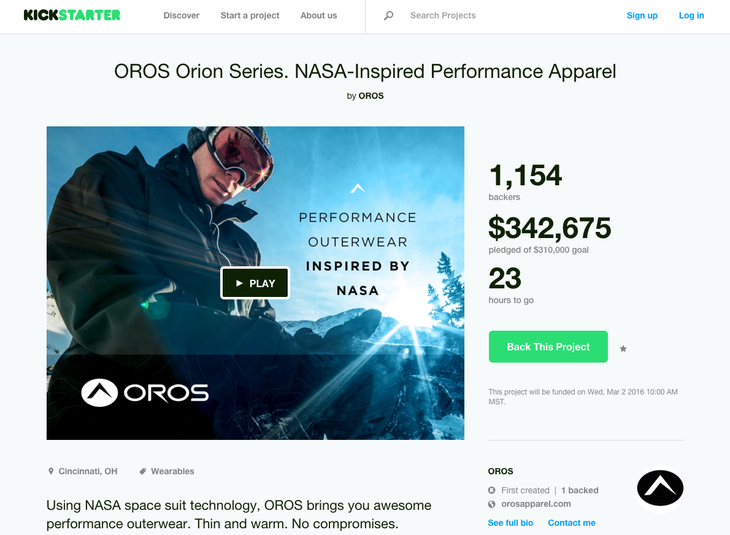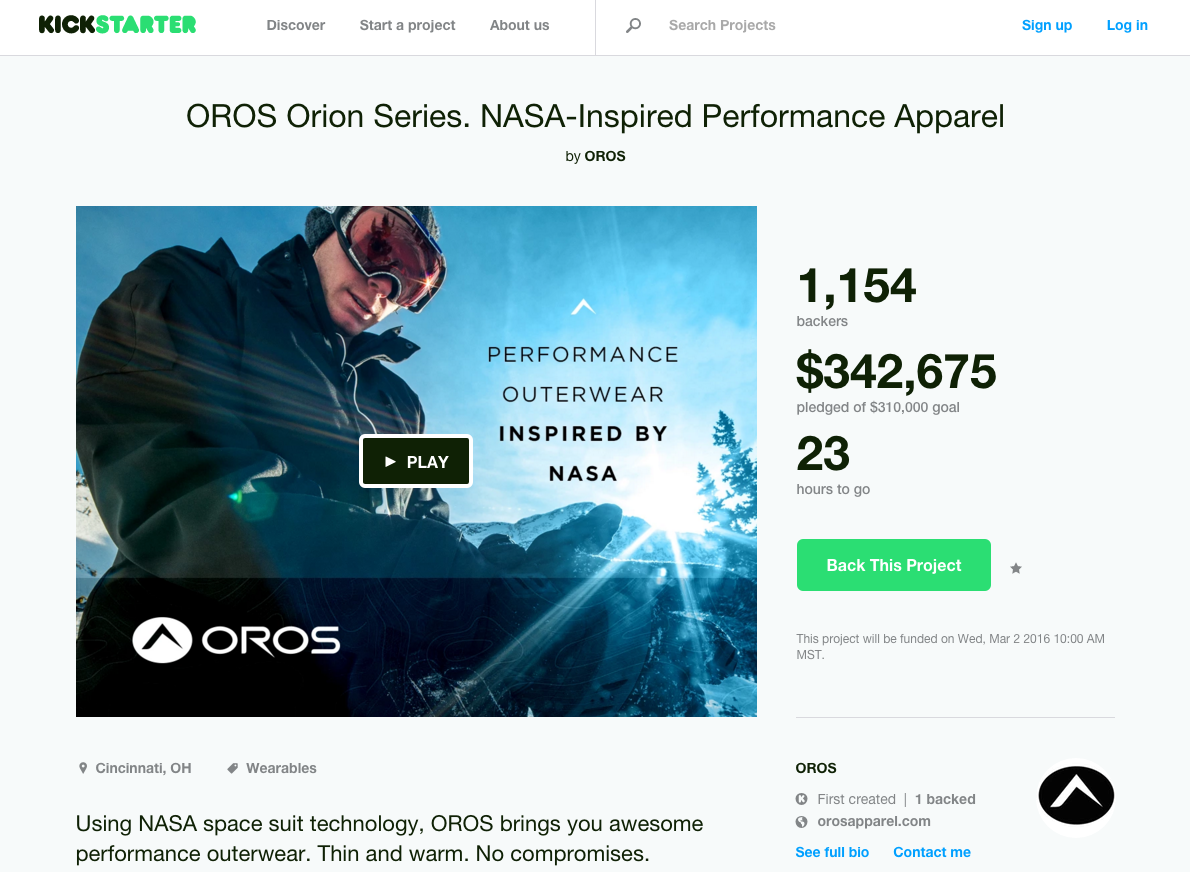When Kickstarter was young, fresh, and newsworthy on its own, at the dawn of crowdfunding, Peak Design founder Peter Dering decided to take a chance. He was sick and tired of slinging his DSLR over his shoulder or neck while hiking, only to have it slam into his body at every move.
So he took to the internet. He Googled die casting in the Bay area and made a prototype of what’s now called Capture, a rigid clip that keeps cameras securely fastened on a belt or backpack strap. He floated the idea on Kickstarter – after much planning and pitching to media outlets, so potential funders would know the campaign was on the way – and the money started rolling right in. Hundreds of thousands of dollars of it.
At the time, in 2011, Peak Design had created the second-most funded Kickstarter campaign of all time. Last year, Peak Design raised nearly $5 million in its fifth run on the crowdfunding site.
You could argue that Dering got lucky. Maybe he rode the newsworthiness wave that crowdfunding created and his project went viral, so his company succeeded and that was that. But many other outdoor companies have also found strong, consistent support on the platform, and they have far too much in common for their success to be dismissed as happenstance.
“All of the things that make a successful crowdfunded company are the exact same things that make a successful regular company,” Dering said during a seminar at Outdoor Retailer Winter Market. “Kickstarter is simply an amplification mechanism.”
We spoke with several veterans of Kickstarter, and they all had the exact same piece of obvious advice: successful campaigns are made by hard work and months and months of planning. But there’s no question that it’s worth it.
“You’re asking people to buy something sight unseen,” said Joanna Griffiths, founder of Knix Wear, which makes women’s underwear and recently crowdfunded more than $1 million for its Evolution Bra. “It’s really about the story.”
The way you tell that story is vital to whether the campaign will go viral, as is the amount of planning that goes into marketing the campaign long before you hit the “go” button. Griffiths and other founders of successful Kickstarter campaigns say they plan and market for months ahead of the campaign.
Every step of the process has to be ready to go, which includes having samples to hand to journalists before the campaign starts and a manufacturer ready to produce the products once the money is in hand. It’s serious business to fall short of backers’ expectations when their trust and your future campaigns are at stake.
“Prepare. I’m not talking prepare a week in advance, two weeks in advance,” said Michael Markesbery, founder of Oros, which is currently in its second Kickstarter campaign for pants and jackets insulated with space-age aerogel. “Sit down three months in advance, and do research. The second you press that button, everything should already be done. You should have media content prepared for the next month.”

It all starts with a killer product that solves a problem countless consumers face. It doesn’t have to save the world, but it has to make people slap their foreheads and say, “Damn. I wish I had thought of that.”
“What makes it successful, I think, is how big of a problem you are solving (with your product),” Dering told ���ϳԹ��� Business Journal.
Maybe it’s an age-old problem – like Knix Wear’s solution to comfortable yet unattractive sports bras – or a problem consumers didn’t even realize they had.
“I don’t think Kickstarter would work for brands that are just doing incremental improvements or launching a new color of a sweater or something,” said Chris Dickey, of Purple Orange PR, which has worked with Peak Design, United By Blue, and DMOS Collective on several Kickstarter campaigns. Kickstarter is a place for innovation, Dickey said, and there’s no reason big companies can’t be successful there. But they have to be attention-grabbing and create products that have never existed in that space.
Dering initially asked for $10,000 to make Capture a reality, but what he got was $364,698. Since then, the company has made millions more over the course of four more campaigns. Most recently, Peak Design’s Everyday Messenger Bag made $1 million in less than four days, and topped out at nearly $5 million.
Those first 24 to 48 hours are what really make or break a campaign, Griffiths said. What may seem like a flood of money at first can quickly taper later in that first week.

It’s Not (Just) About the Money
Knix Wear’s Evolution Bra takes everything you thought was true about underwire and what makes a bra supportive and throws it out the window – the OBJ team got to try a few, and we can attest to that. There’s no underwire, and no uni-boob, yet it stays supportive for skiing, hiking, yoga, and everyday life.
But long before the product has hit shelves, thousands of women put their money behind Knix Wear to make it a reality. Knix Wear raised $1.1 million, far exceeding its goal of $30,000. Customers can pre-order the Evolution Bra on Indiegogo now, and the total amount funded has reached more than $1.4 million.
Griffiths asked early backers what size and color bras they wanted, and extrapolated that data to create the basis for the bra’s size and color run once it hits shelves. Money and data aside, Kickstarter has also resulted in huge brand recognition for Knix Wear.
“Kickstarter is thought of as fundraising, but it is better to think of it as a marketing campaign,” outerwear brand Mishmi Takin founder Kapil Dev Singh wrote in an email. “Previous campaigners have told me that… your costs frequently either equal or outstrip the money you raise even through a successful campaign. So, a Kickstarter campaign is really a way to build a brand, raise awareness, and get committed backers in advance, with a side benefit of raising some money.”
Mishmi Takin will start a campaign in the next couple of weeks to fund breathable waterproof boots Singh said are suitable for the humid tropics of the Eastern Himalayas, where he’s from. Incentives for supporters who fund the project with at least $5,000 include trips to the Himalayas, personally guided by Singh.
Taking Advantage of Kickstarter’s Community
Part of Knix Wear, Oros, and Peak Design’s repeated success comes with the Kickstarter territory – they are well known to their backers in that community, and so funding in their later campaigns has come from many second-, third- or even fifth-time supporters.
That huge Kickstarter community, the data companies are able to get about their backers, and Kickstarter’s reputation are what keep companies coming back rather than funding on other sites that are out there.
“None even come close to Kickstarter in terms of reputation, size of the network, and cleanliness of the brand,” Dering said, adding that Kickstarter hasn’t allowed crowdfunding to become a grotesque money-grabbing outfit. Kickstarter also doesn’t change its fee structure based on how much money campaigns raise. “They just keep it clean. They are very, very level across the board with everyone, and I really like that.”
The long list of outdoor companies that have gotten their start or launched innovative products through Kickstarter continues to grow: United By Blue funded bison down socks and bison down-insulated jackets; women’s adventure apparel company Shredly funded its first production run; Canamia Outdoors funded hanging treehouses called TreePods; Oru created the foldable, portable kayak; and Dish & Duer made “no sweat” performance pants dressy enough to wear to the office. Many companies don’t stop after their first campaign – like Knix Wear and Peak Design, they use that momentum and continue to have great success.
“It’s really an e-commerce platform,” Dickey said. “It’s an innovative, personal commerce platform where you get to be part of an inner circle of a company. … You have a special bond with the company and the people that are creating the product, and that doesn’t exist anywhere else.”


